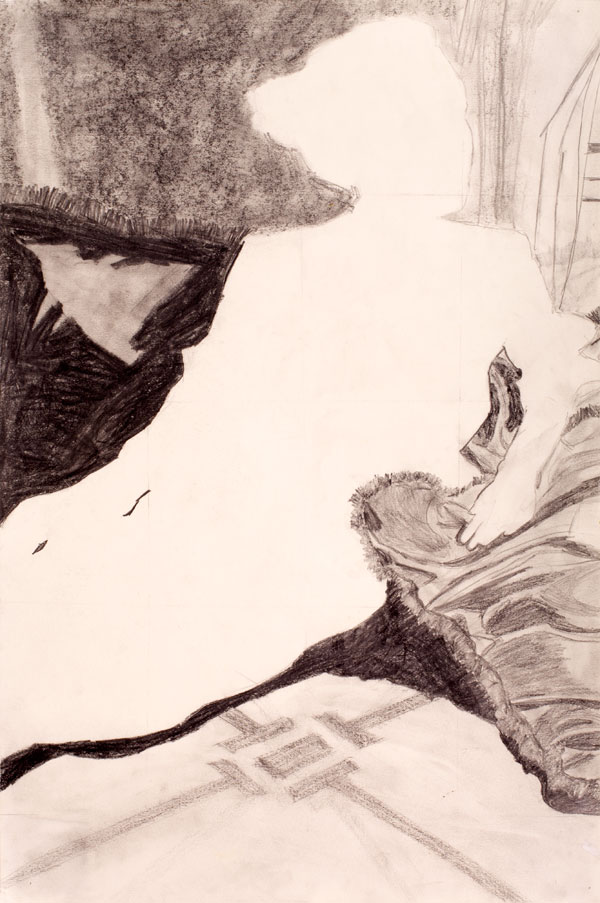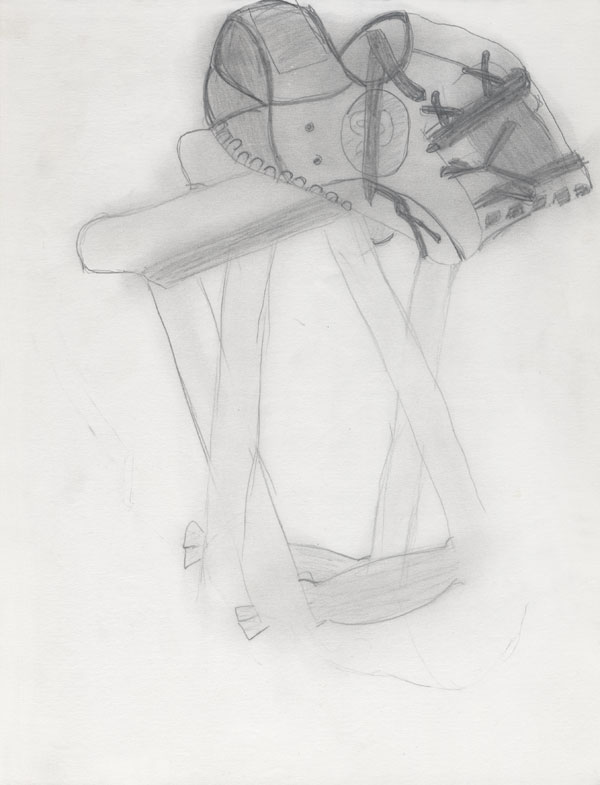MY STRUGGLE WITH PAIN
My story and experiences...

This is a picture I drew of an empty woman looking out a window, while everything in the background is shown in detail. She's looking out to the right and her legs are out to the left.
When I was in eighth grade, I was playing basketball in my backyard and I fell, rolling my right ankle. My dad was out of town and my mom immediately took me to the doctor. They told me that I had torn two ligaments in my ankle and I would have to be on crutches for a while, plus I had to wear a "boot" to support my injury. This was a big deal because, since I was five, I had been a very serious athlete. I had played basketball, soccer, baseball/softball, and danced very successfully. But I had to do what I had to do, so I did exactly what the doctor told me to. I stayed off of it and started going to physical therapy twice a week. During the healing process I continued to support my various teams and went to games and practices and stayed involved. When I was healthy again and my ankle was stronger, I started back up in my sports.
I remember the first time I felt my chronic pain. It was during a soccer practice and the pain started out in my right leg. It felt like a lightning bolt of pain going up and down the outer side of my thigh. The thing that puzzled me was that it happened even when I wasn't putting pressure on it, which is odd for a normal injury. I played through the pain for a couple of practices and iced it, but it didn't stop bothering me. A week or so after my leg pain started, my lower back started hurting. In one spot in my back I felt a huge amount of pressure, like someone was just pushing into it really hard and constantly. It was a completely different pain than what was going on with my leg. I would ask my mom to massage my back, but it would keep hurting.
We decided to talk to the same doctor we saw for my ankle. The first thing she did was send me to take x-rays -- nothing showed up. Then I took my first MRI of many, which was not fun at all. When my doctor got back the results, she told me that I had a herniated disc in my lowest disc.
She put me on steroids for about a week, which no one in my family appreciated. I definitely had 'roid rage' for a while. I went back to my physical therapist and we treated a herniated disc for a while, but the pain was actually getting worse. So, we decided to get a second opinion and went to a different doctor who did his various tests. He said that it actually wasn't a herniated disc, but that the technician that took my MRI, took it at the wrong angle, making my disc look elongated when it really wasn't.
Now we had to start over from scratch and went to more doctors than I could count. I got diagnosed with bursitis and the doctor wanted to shoot me up with steroids into my thigh. He said that I would have a permanent bulge where the shot was, but my dad was not going to let that happen, so that doctor referred us to someone else. The next diagnosis was that my legs were of unequal length, but a pad in my shoe didn't help at all. I went to countless doctors and went through many tests, procedures, and medications, including accupuncture, which I hated, but sometimes helped temporarily.
A new doctor studied my MRI's and x-rays like no one else had. He found something called spondylolysis. That doctor decided putting me in a body cast from the breast down to my knee was best for me. Turns out that he was wrong, so I spent a month in that thing for nothing. It was during that month that I was asked to drop out of school -- my life.
I started getting terrible panic attacks because the stress was just too much. I would pass out randomly, even if I was walking, and have psuedo-seizures. Mid-conversation I would just lose consciousness, which meant that I could not go out with friends anymore because it was dangerous. I spent long evenings in emergency rooms and hospitals with my Dad. I got poked and prodded, but still no answers. I would get accused of faking the pain to get attention so often because no doctor could find a reason for my pain. It was torture for me and my family going through this, because no one really believed me. A couple of doctors wanted to do exploratory surgery, and one wanted to do an epidural on me.

I drew this picture of my softball glove -- my passion -- laid on my crutches. It shows the compromise I had to make and the things I had to give up because of this illness.
Finally, we found a pain management clinic in our city that I owe all of my success to. Instead of drugging me up with medicine, they took a natural approach. They taught me how to think positively and helped me through it. The clinic provided a huge variety of different therapies and I did many of them. I tried psychotherapy, hypnotherapy, family therapy, art therapy, Iyengar yoga, physical therapy, accupuncture, craniosacral massage, and medication management (for details on those and more helpful methods go to HOW TO GET THROUGH IT). Yoga and hypnotherapy helped me the most, even though those were two of the ones that I was most skeptical about in the begining. I found it very hard to believe that hypnotherapy would help relieve my back pain, but it did.
It took me over a year, many hospital visits, more doctors' offices than I could count, an ambulance ride, and going twice a week to each of my activities to get well. It took a long time and a lot of hard work, but I got there. I took my high school courses online, so I was able to get back to my school and my friends by the next semester. That semester I played softball for my school -- my childhood dream -- and my life was completely back to normal. I am so blessed to have friends and family that were there to support me with everything, because it wasn't easy for any of us. But, we got back and that's what is important.
